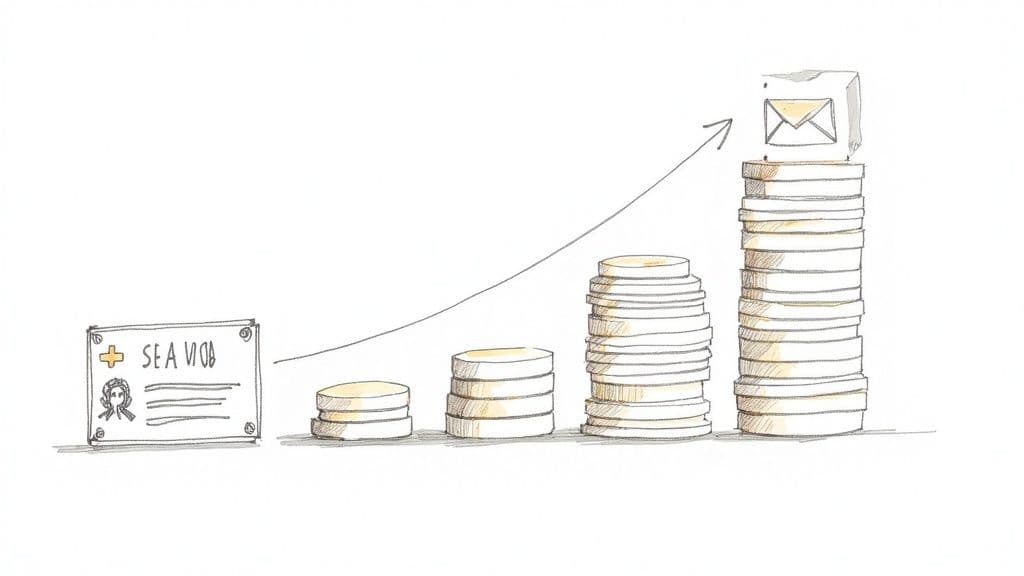So, you're planning a trip to the United States. It's an exciting prospect, but before you start daydreaming about sightseeing, there's a crucial first step for many international travelers: getting a US visitor visa. And that process comes with a price tag.
While you've probably heard about the main application fee, the true cost can be a bit more complex. Let's break it all down so you can budget properly and avoid any financial surprises along the way, whether you're applying from Mexico, Colombia, or as an Indian citizen living in Canada.
Your Guide to the True Cost of a US Visa
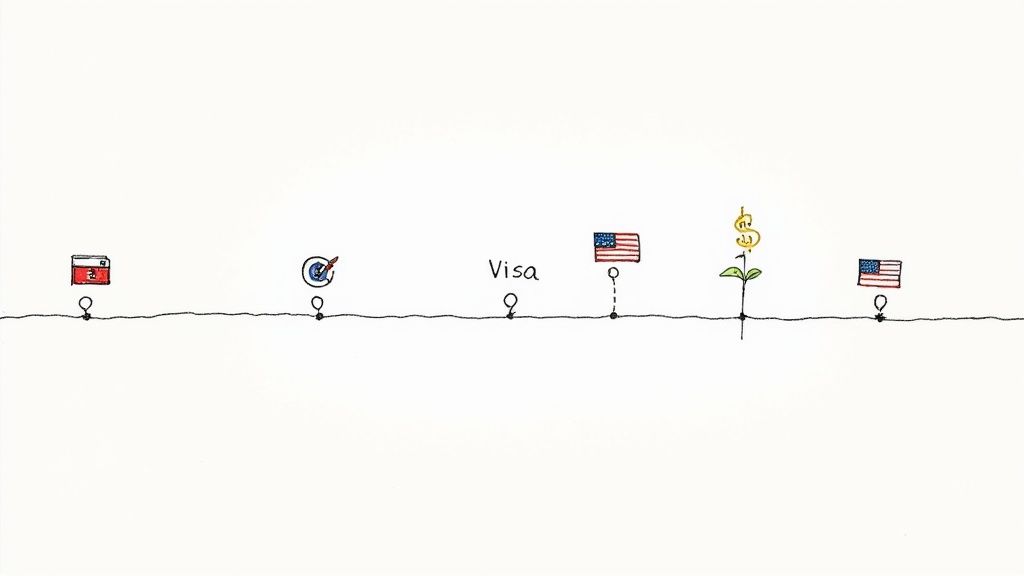
When you start the visa application, you'll see the standard government processing fee for a visitor (B1/B2) visa is $185 USD. It's easy to assume that's the final number, but it's really just the starting line.
Think of it like buying a plane ticket. The base fare gets you a seat, but you still have to account for luggage fees, seat selection, and maybe an in-flight snack. The visa process is similar. The $185 fee is just the base—other costs for photos, passport services, and even country-specific fees can add up.
This guide will give you the full financial picture, so you can plan with confidence.
What This Financial Roadmap Covers
We're going to map out every possible expense you might run into. Knowing these costs upfront helps you focus on what really matters: preparing a strong application. Here’s a look at what we’ll cover:
The Main Government Fee: We'll dive into the non-refundable Machine Readable Visa (MRV) fee that every single B1/B2 applicant pays.
The "Other" Costs: This is where we uncover those extra expenses that can catch you off guard, like reciprocity fees, visa photos, and passport courier services.
Budgeting Like a Pro: By the end, you'll have a clear financial roadmap to help you prepare for the total investment required.
Let's take a quick look at the typical costs you might encounter for a B1/B2 visa.
US Visitor Visa (B1/B2) Cost Breakdown at a Glance
Expense Category | Estimated Cost Range (USD) | Is This Fee Always Required? |
|---|---|---|
MRV Application Fee | $185 | Yes |
Visa Photos | $5 - $20 | Yes |
Passport Courier Service | $0 - $30 | Often, depends on location |
Reciprocity Fee | Varies by country ($0 - $300+) | Only for citizens of certain countries |
This table gives you a quick snapshot, but keep in mind that fees can change and vary based on your specific situation and location.
A successful application is a well-prepared one, and that includes your finances. Knowing all potential costs upfront allows you to focus on what truly matters—presenting a strong case for your visit to the U.S.
Of course, none of this can happen without a valid passport, which is a separate process with its own set of fees. If you're starting from scratch, you'll want to factor that in, too. For a complete overview, check out our guide on the cost of a passport.
Breaking Down the Main Government Application Fees
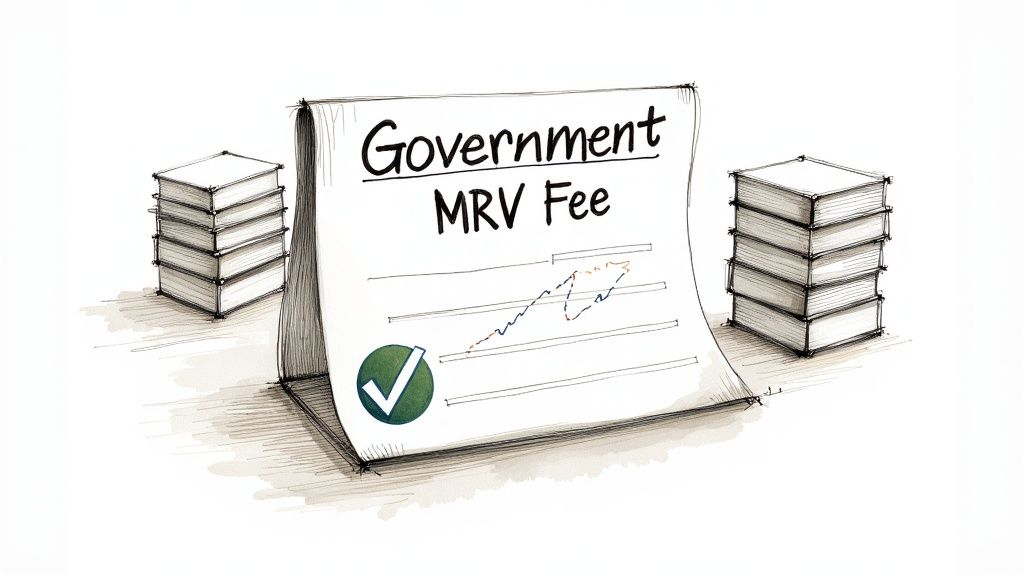
The first cost you'll run into on your visa journey is the official government application fee. This is officially known as the Machine Readable Visa (MRV) fee, and it’s the non-refundable, mandatory price of getting your application processed. Think of it as the foundation of your total visa cost.
Essentially, the MRV fee is your ticket to get a consular officer to review your case. It pays for the administrative work involved, and you have to pay it whether your visa is ultimately approved or denied. For most common visitor visas, like the B1/B2, this fee is currently $185 USD.
Paying this fee is a critical first step. You can't even book your visa interview appointment without it, so it’s the key that unlocks the rest of the process.
What the MRV Fee Covers (and What It Doesn't)
So, what are you actually paying for? The MRV fee covers the cost of processing your DS-160 application form and conducting your interview. It's a one-time charge for a single application attempt.
It's just as important, though, to understand what this fee doesn't cover. Knowing this upfront will save you from surprise expenses down the road.
What's Not Included: The MRV fee won't cover any potential visa issuance fees (often called reciprocity fees), costs for third-party services like getting visa photos taken, courier fees for passport delivery, or your travel expenses to get to the embassy or consulate.
No Guarantees: Paying the fee doesn't mean your visa is approved. You're paying for the service of processing your application, not for the visa itself.
Keeping this distinction in mind helps you build a realistic budget for the entire process, not just this initial government charge.
How B1/B2 Visa Fees Stack Up Against Other Categories
While $185 is the going rate for visitor visas, the U.S. Department of State has a whole schedule of fees for different visa types, usually based on how complex they are to process. It helps to see where the B1/B2 fee falls in the grand scheme of things.
For instance, petition-based visas for temporary workers (like H, L, O, P, Q, and R visas) involve a lot more administrative lifting, so they naturally cost more. The U.S. government periodically adjusts these fees to reflect the real cost of doing the work. In fact, on June 17, 2023, the fee for many of those petition-based visas went up from $190 to $205.
These adjustments are based on a detailed costing model to ensure the fees actually cover operational expenses. You can read more about these U.S. visa fee updates to see how they're calculated.
Your MRV fee is the starting point of your financial planning. Treat it as the non-negotiable entry fee, and then build the rest of your budget around the other potential costs you'll encounter.
This comparison shows that the B1/B2 visa fee, while significant, is pretty standard within the broader nonimmigrant visa system. Having this context is valuable as you prepare for your own application.
Uncovering the Hidden Costs of Your Application
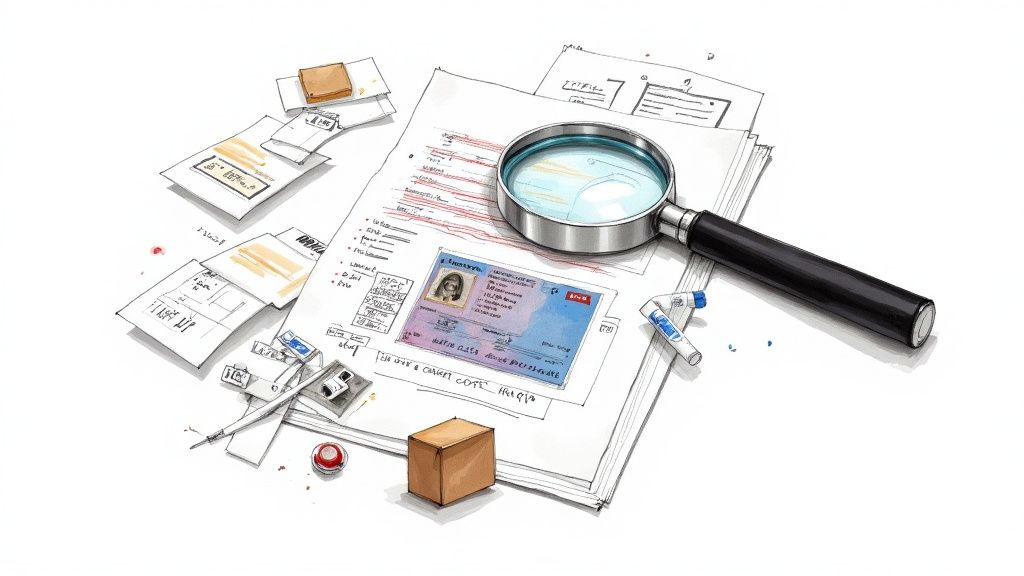
So, you’ve budgeted for the $185 MRV fee. That’s a great start, but it's really just the price of admission. Think of it as the ticket to the main event; there are still other costs you'll run into before the show is over.
These aren't optional upgrades. They are often mandatory parts of the process that can catch you by surprise if you're not prepared. Let's pull back the curtain on these "hidden costs" so you can build a realistic budget and avoid any last-minute financial stress.
What in the World Are Reciprocity Fees?
One of the biggest potential expenses is something called a reciprocity fee, which you might also hear called a visa issuance fee. This is a tricky one because you only pay it if your visa is approved, right after your interview.
Don't worry, it's not a penalty. The logic is simple: if your country charges a U.S. citizen a fee for a similar visa, the U.S. will charge you a similar fee in return. It’s a “you charge us, we charge you” kind of deal. For instance, an applicant from Chile might have to pay one, while someone from South Africa won't.
The bottom line is that reciprocity fees are completely dependent on your nationality and only come into play once you're approved. Before you go to your interview, always check the U.S. Department of State's fee schedule for your country to see if this applies to you.
Other Essential Application Expenses
Beyond that, you have a few smaller but equally important costs that are necessary to get your application package ready for review. These are the nuts and bolts required by the U.S. government.
Here’s a quick rundown of the most common extras you should plan for:
Official Visa Photos: You can't just snap a selfie. The U.S. government has very specific rules for visa photos—we're talking size, background, and even your expression. Getting compliant photos done professionally will typically set you back $5 to $20.
Medical Examinations: Most B1/B2 applicants get to skip this step. However, a consular officer can require a medical exam if they have specific concerns. If you’re asked to get one, you have to use an embassy-approved doctor, and that can cost several hundred dollars.
Passport Courier Services: Once your interview is done and your visa is (hopefully) approved, they don't just hand your passport back. You’ll need to arrange for a designated courier service to return it, which usually adds another $20 to $30 to your final tally.
Putting together all the right paperwork is just as crucial. To make sure you don't miss a single document, take a look at our complete B-2 visa documents checklist. It’ll help you get everything organized.
How to Navigate the Visa Fee Payment Process
Getting the visa fee paid correctly is a make-or-break step in your application. While the fee amount itself is standardized, how you actually pay can vary wildly depending on the U.S. embassy or consulate in your country of application. You absolutely have to get this part right to keep your application moving.
Most of the time, you'll have two main options: paying online with a debit or credit card, or making a cash payment in person at a designated local bank. For instance, if you're applying in Mexico, you'll head to a Scotiabank or Banamex. In Colombia, it's specific Itaú bank locations. The key is to check and follow the exact instructions for your country.
No matter which method you use, your first step is always on the official U.S. visa services website for your country. This is where you'll generate a payment slip—think of it as your personalized invoice for the visa fee.
Understanding Your Payment Slip and CGI Number
The single most important piece of information on that slip is the CGI reference number. This number is like your payment’s unique fingerprint. It's the digital glue that connects your payment directly to your DS-160 application form and your online visa profile, making sure the U.S. government knows you've paid your dues.
Once your payment is recognized, the system unlocks the appointment scheduling calendar for you. Without a paid and processed CGI number, your application is stuck in limbo. Just be sure to check the expiration date on the deposit slip—if you don't pay in time, you’ll have to go back and generate a brand new one.
Crucial Takeaway: Your MRV fee payment is strictly non-refundable and non-transferable. If your visa application is denied, or if you simply change your mind and cancel, that money is gone. The fee covers the work of processing your application, regardless of the outcome.
After you've paid, you'll get a receipt. Guard this document carefully, as it's the proof you'll need to book your interview. It can take up to two business days for the payment to process, but once it does, you can log back into your profile and get that appointment on the calendar.
Your Payment Receipt's Validity Period
It's really important to understand that your MRV fee receipt doesn't last forever. It has a shelf life. Typically, the receipt is valid for 365 days from the day you pay. This gives you a one-year window to schedule an interview at an embassy or consulate.
If you don't book an appointment within those 365 days, your fee expires. Poof. It’s gone. You'll lose the money and have to pay the entire cost of the US visa application all over again to continue. A little bit of planning here can save you a lot of money and frustration.
For some expert tips on locking in a good date, check out our detailed guide on how to get a US visa appointment booking. Once you've successfully handled the payment and scheduling, you're one giant step closer to that all-important interview.
Comparing Fees Across Different US Visa Types
While you’re focused on the B1/B2 visitor visa, it helps to see how its $185 fee stacks up against other U.S. visas. The costs aren't one-size-fits-all; they generally reflect the complexity of the application and the amount of work required from government agencies.
Think of it this way: a visitor visa is like a standard entry pass. It's straightforward. Other visas, especially those for work or permanent residency, are more like backstage passes—they grant more privileges but require a much more thorough vetting process, and their price reflects that.
This quick comparison helps put the B1/B2 fee into perspective.
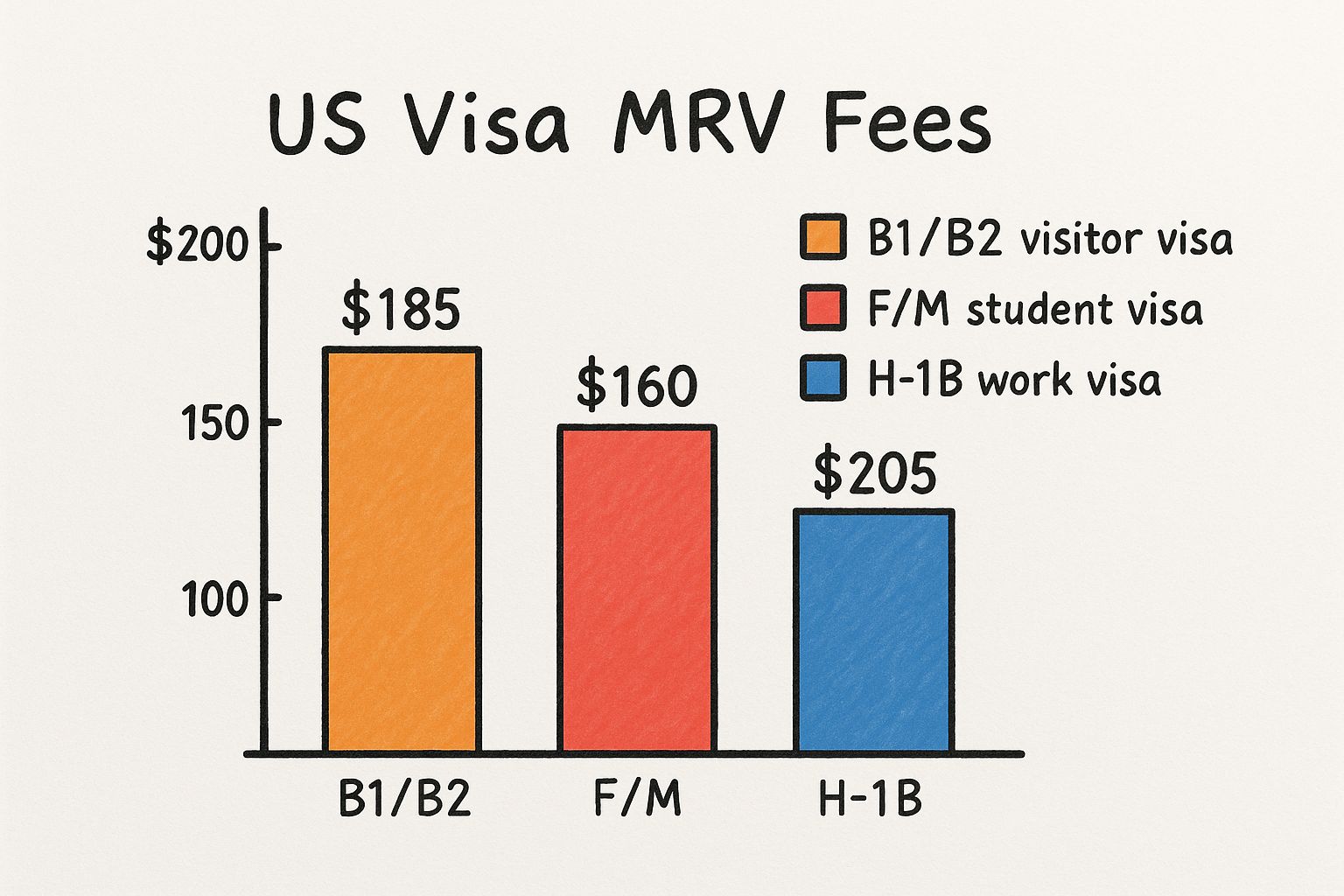
As you can see, the fee is a bit more than a student visa but less than petition-based work visas, which gives you a hint about where it falls on the complexity scale.
To give you a clearer picture, here’s a breakdown of the base application fees for some of the most common visa categories.
Comparison of Common US Visa Application Fees (by Visa Category)
This table offers a comparative look at the base government application fees for different types of U.S. visas.
Visa Category | Common Visa Types | Base Application Fee (USD) |
|---|---|---|
Visitor & Other Non-Petition Visas | B (Business/Tourism), F (Student), J (Exchange Visitor), I (Media) | $185 |
Petition-Based Work Visas | H (Temporary Workers), L (Intracompany Transferees), O (Extraordinary Ability), P (Athletes/Artists), Q (Cultural Exchange) | $205 |
Treaty Trader/Investor Visas | E (Treaty Trader/Investor) | $315 |
Fiancé(e) Visas | K (Fiancé(e) of a U.S. Citizen) | $265 |
Keep in mind these are just the initial government application fees. The total cost can be much higher once you factor in additional expenses.
A Look at Employment and Immigrant Visas
The financial commitment changes significantly when you shift from temporary visits to work-based or immigrant applications. These paths involve more government bodies, a mountain of paperwork, and often, hefty legal fees covered by a sponsoring employer.
Take the H-1B visa, a common choice for skilled professionals. The employer pays a base filing fee of $205, but that's just the start. When you add in mandatory anti-fraud fees, legal counsel, and other charges, the total cost for the company can easily soar into the thousands. For companies navigating this, our guide on business visa requirements for the US offers more detailed insights.
The Higher Stakes of Immigrant Visas
For those aiming to live in the U.S. permanently, the costs climb even higher. Immigrant visas, the pathway to a Green Card, operate on a completely different and more expensive fee structure because they confer permanent residency—a life-changing benefit.
The journey to U.S. residency is a multi-step marathon, not a sprint. Unlike the single, non-refundable fee for a visitor visa, immigrant visa costs are tiered, adding up over time as you clear each stage of the process.
The fees vary widely depending on the type of application. For instance, immigrant visa processing fees for immediate relatives and family-preference applicants are $325 per person. Employment-based applications are $345, while other categories, like special immigrant visas, are $205.
This comparison makes one thing clear: while the B1/B2 fee is a real expense, it represents one of the most financially accessible routes for temporary entry into the United States.
Your Top US Visa Cost Questions Answered
Let's be honest, the money part of applying for a U.S. visa can be confusing and a little stressful. You've got questions, and you need straight answers to budget properly and avoid any costly mistakes. We'll walk through the most common questions people have about the fees, one by one.
Getting these details straight will give you the confidence to handle the financial side of your application without any surprises.
Is the US Visa Fee Refundable if My Application Is Denied?
This is the big one, and the answer is a firm no. The Machine Readable Visa (MRV) fee, which is $185 for most visitor visas like the B1/B2, is non-refundable.
Think of it this way: you aren't buying a visa. You are paying for the service of having a consular officer review your case. The fee covers the time and administrative work it takes to process your documents and conduct an interview. That work gets done whether you're approved or not, which is why the fee can't be returned.
This policy holds true even if you change your mind and decide to withdraw your application. Once that payment goes through, it's final.
How Long Is My Visa Fee Payment Valid For?
Your visa fee payment doesn't last forever. After you pay, the receipt you get is good for one year (365 days) from that date.
This one-year window is your deadline to schedule an interview appointment. If you don't book an interview within those 365 days, your fee receipt expires. You lose the money and have to pay the full cost of the US visa application all over again to move forward.
This is a critical detail to track, especially when interview slots are hard to come by. The key is to be proactive and schedule your appointment as soon as you can so your payment doesn't go to waste.
Can I Transfer My Visa Fee to Another Person or Country?
Unfortunately, no. The MRV fee is also non-transferable. It's locked into your specific application profile and can't be handed over to someone else, not even a close family member.
It's also tied to a specific country. A fee paid to apply in Mexico, for example, can't be used to book an interview in Argentina. If your plans change and you need to apply from a different country than where you first paid, you'll have to pay a new fee there.
Are There Any Fee Waiver Exceptions?
For B1/B2 visitor visas, fee waivers are incredibly rare. They're typically reserved for very specific diplomatic or government-sponsored situations, not for the average tourist or business traveler.
A few exceptions exist, but they generally apply to:
A and G visa applicants traveling on official government business.
Certain J visa applicants in U.S. government-funded exchange programs.
Individuals traveling for very specific, pre-approved charitable activities.
For the vast majority of people applying for a B1/B2 visa for tourism, family visits, or business meetings, the fee is a required step. If someone in the U.S. is helping to cover your trip's costs, they can mention this in an invitation letter for a US visa to help support your application.
Frustrated by long visa wait times? Vast Fisa finds and books earlier appointment dates for you automatically, supporting applicants in countries like Mexico, Colombia, Brazil, and many more. Skip the endless manual checking and secure your interview slot faster. Try Vast Fisa today and take control of your visa timeline.
